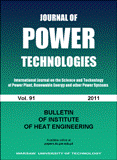Thermal-hydraulic Design of a Small Passively Liquid-Metal-Cooled Reactor
Abstract
The influence of bypass flow size and thermal shielding on the overall performance of a small pool-type liquid-metal-cooled reactor are investigated through the use of 3D computational fluid dynamics. 1/4 of the reactor is modeled using a porous media approach for small-detail domains, such as the core and the heat exchangers, and a full conjugate heat transfer approach for all relevant walls. Through the introduction of thermal shielding on the internal wall and an optimal bypass flow based on the ratio of pressure drops over the core and heat exchangers, most of the critical design parameters are in good agreement. The results show that for a well functioning design the pressure drops of the core and the heat exchanger should be close in value, which can be achieved by selecting the right bypass flow.
Published
2025-03-02
How to Cite
THIELE, Roman; ANGLART, Henryk.
Thermal-hydraulic Design of a Small Passively Liquid-Metal-Cooled Reactor.
Journal of Power Technologies, [S.l.], v. 105, n. 1, p. 1 -- 14, mar. 2025.
ISSN 2083-4195.
Available at: <https://papers.itc.pw.edu.pl/index.php/JPT/article/view/710>. Date accessed: 30 may 2025.
Issue
Section
Nuclear Power
Keywords
liquid lead; conjugate heat transfer; GEN IV; design optimization
Authors who publish with this journal agree to the following terms:
- Authors retain copyright and grant the journal right of first publication with the work simultaneously licensed under a Creative Commons Attribution License that allows others to share the work with an acknowledgement of the work's authorship and initial publication in this journal.
- Authors are able to enter into separate, additional contractual arrangements for the non-exclusive distribution of the journal's published version of the work (e.g., post it to an institutional repository or publish it in a book), with an acknowledgement of its initial publication in this journal.
- Authors are permitted and encouraged to post their work online (e.g., in institutional repositories or on their website) prior to and during the submission process, as it can lead to productive exchanges, as well as earlier and greater citation of published work (See The Effect of Open Access).


